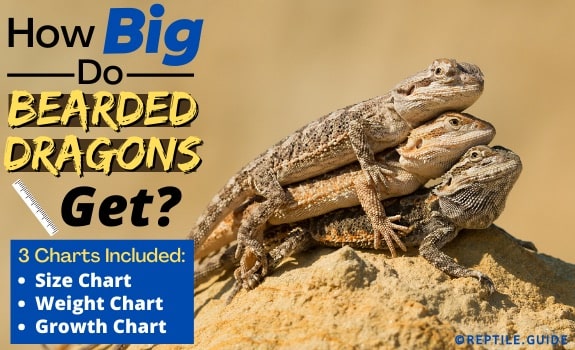Unlike cats and dogs, it can often times be a little tricky to estimate how large a baby bearded dragon will grow, especially if you’ve never been around one!
But, rest assured… if you find yourself wondering what the size of a full grown bearded dragon is, you’ve come to the RIGHT place!
Familiarizing yourself with the bearded dragon growth rate will provide you, at the very least, a basic understanding of when you’ll need to purchase a larger tank.
And if you haven’t adopted a bearded dragon yet? Well, knowing what an adult bearded dragon looks like in terms of size will also help you decide if they’re the right pet for you AND your home.
You see, in this article we’re leaving NO stone unturned when it comes to all things bearded dragon size.
Specifically, This Article Will Answer the Following Questions Relating to Bearded Dragon Size:
- How big do bearded dragons get?
- How fast do bearded dragons grow?
- How long do bearded dragons get?
- What does a full grown bearded dragon look like?
- Why isn’t my bearded dragon growing or gaining weight?
- And many more!
So, if you’d like to discover bearded dragon size by age, just keep reading!
In This Article
How Big do Bearded Dragons Get?
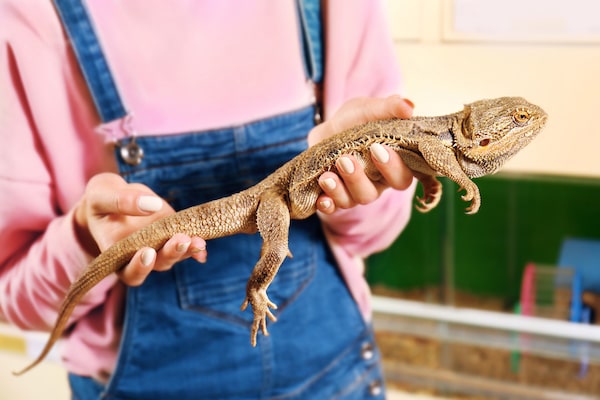
A full-size bearded dragon will most often measure between 16 and 24 inches. These full grown bearded dragons will also most often weigh between 300 and 550 grams, with the average weight being around 400 grams.
A bearded dragon grows to its full size by 18 months of age, at which point they are considered an adult and sexually mature.
However, it is not uncommon for bearded dragons to be done growing by 12 months of age.
Most bearded dragon owners will agree there are 3-4 primary age groups for a bearded dragon.
Expect your bearded dragon’s growth rate to mirror the amounts in each category below…
Baby Bearded Dragon Size
A new born baby bearded dragon will typically measure around 3 inches long and will weigh as little as 4 grams.
Bearded dragons are regarded as “hatchling” from the moment they’re born through 2 months of age.
Once they reach 2 months of age, hatchlings will typically have doubled or even tripled their length, and gained anywhere from 4 to over 30 grams.
Juvenile Bearded Dragon Size
A juvenile bearded dragon can range in size anywhere from 8 to 23 inches long and weigh between 20 and 400 grams.
Juvenile bearded dragons are those that are between 3 and 11 months of age.
These bearded dragons experience the MOST dramatic growth rate, with most having nearly reached their final size by month 11.
This dramatic size range is due to the long 8 months of growing juveniles undergo.
Sub Adult Bearded Dragon Size
Expect the average sub adult bearded dragon to measure between 15 and 24 inches and weigh between 300 and 500 grams.
Sub adult bearded dragons are those that are between the ages of 12 and 17 months.
During these months, a healthy bearded dragon’s size will change very little, if at all. And any changes might be virtually invisible to the naked eye.
For example, a sub adult bearded dragon may only grow an additional inch between 12 and 17 months of age. On top of this, they may only gain 20 grams.
Adult/Full Grown Bearded Dragon Size
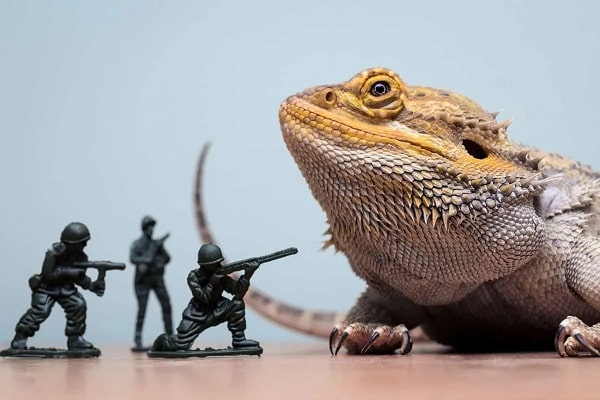
A full grown bearded dragon will typically be anywhere from 16 to 24 inches in length and will weigh on average between 300 and 550 grams.
However, full grown bearded dragons can reach longer lengths, with some growing to be as long as 26 inches. But this is incredibly rare.
As aforementioned, a beardie will be considered an adult bearded dragon at 18 months of age. It is at this point that 99.9% of owners will have their bearded dragon full size.
Full grown bearded dragons that are male will almost always be a bigger size (longer) than full grown female bearded dragons. Males will typically measure 20 to 24 inches in size, whilst females will often measure 16 to 20 inches in size.
As you may have already picked up on, full grown bearded dragons can vary amongst each other in size (weight and length) somewhat depending on a few factors. Because of this, there is no ONE size that is regarded as “normal”.
An adult bearded dragon’s size is MOST determined by…
- Gender
- Diet
- Enclosure quality & size
- Genetics & breed
How Fast do Bearded Dragons Grow?
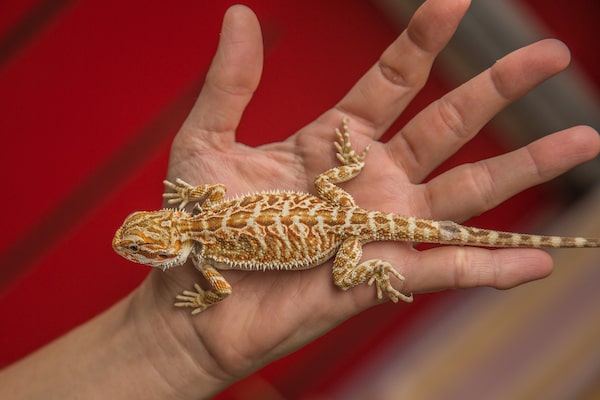
Naturally, any new or prospective pet owner will want to know how long their pet will be growing for.
Knowing such will allow for proper planning and strategy to ensure you have the time, energy, and resources to properly care for a baby for a specific amount of time.
After all, what could be more overwhelming than to have your baby bearded dragon transform into an adult bearded dragon seemingly overnight? Talk about a curveball!
So, just how long does it take a bearded dragon to grow? And when do bearded dragons stop growing?
Although some dragons can continue growing a little bit into their second year of age, many dragons seem to dramatically slow down around 11 to 12 months, typically having reached their full size in length of anywhere from 15 to 18 inches!
Now, this isn’t to say that your dragon doesn’t have more growing ahead of them into their second year, but chances are, it is very little, as in an inch or two.
Also, the speed at which your dragon will continue to grow will be so gradual you may not even notice it. So, don’t be surprised if their size doesn’t appear to change much aft 12 months.
All in all? You can expect most bearded dragons to be 95% done growing by 12 months of age and 99-100% done by 18 months.
Bearded Dragon Growth Rate
Obviously, this is in direct contrast to the growing boom witnessed within the first 6 months, with bearded dragons growing as quickly as an additional inch per week!
It should also be noted that around the year mark, give or take a few months, is when your dragon should start putting on some weight and bulking up.
Expect your adult bearded dragon to begin filling out some and looking less lanky around the 12 month mark.
Bearded Dragon Size Chart
| Age | Size (Length) |
|---|---|
| 1 Month | 3-4 inches |
| 2 Months | 5-9 inches |
| 3 Months | 8-11 inches |
| 4 Months | 9-12 inches |
| 5 Months | 11-16 inches |
| 6 Months | 11-18 inches |
| 7 Months | 13-18 inches |
| 8 Months | 13-20 inches |
| 9 Months | 14-21 inches |
| 10 Months | 15-22 inches |
| 11 Months | 15-23 inches |
| 1 Year | 15-24 inches |
| 18 Months | 15-26 inches |
The bearded dragon size chart above will help give you a more specific idea of bearded dragon size by age.
By consulting the chart, you will be able to better gauge by how long bearded dragons grow for and at what point this growth dramatically slows down.
However, it is important to note that these lengths are all estimates and averages. So, if your bearded dragon’s size is shorter than the sizes listed below, it doesn’t necessarily mean they’re unhealthy or that their growth is stunted.
Bearded Dragon Weight
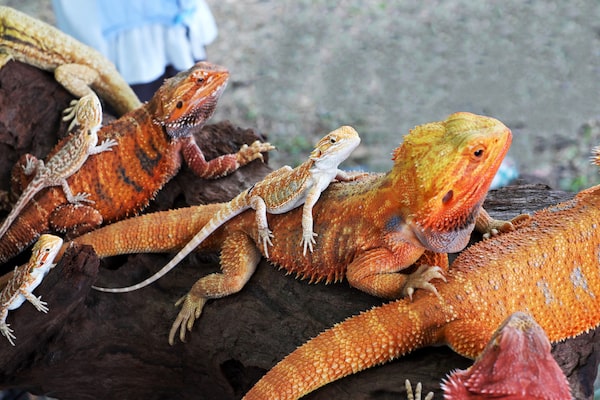
When they’re born, baby bearded dragons are tiny, weighing about the same as a single sheet of paper! Yet, their size doesn’t stay small for long…
You see, these itty bitty babies can gain as much as 400x (or more!) their birth weight by the time they reach adulthood. And many of them will double their birth size within a week or less.
Bearded Dragon Weight Chart
| Age | Weight |
|---|---|
| 1 Month | 4-6 grams |
| 2 Months | 8-40 grams |
| 3 Months | 20-110 grams |
| 4 Months | 40-115 grams |
| 5 Months | 100-150 grams |
| 6 Months | 180-225 grams |
| 7 Months | 225-280 grams |
| 8 Months | 230-325 grams |
| 9 Months | 250-350 grams |
| 10 Months | 260-375 grams |
| 11 Months | 280-400 grams |
| 1 Year | 300-450 grams |
| 18 Months | 300-550 grams |
On top of closely monitoring your bearded dragon’s length, you should also pay attention to their weight.
How to Tell If a Bearded Dragon Is Overweight
An overweight bearded dragon will look especially round, with a belly that can be seen from above, fat legs, and a very full chest.
If you believe your bearded dragon to be overweight, you should first check their tank’s temperatures to make sure they are where they need to be.
If the temperatures get too high, this can lead to a bigger size bearded dragon, as the temps will trigger their appetite and cause them to eat more food than they would normally.
As a reminder, you’ll want to aim for a basking spot between 95 and 100 degrees Fahrenheit for bearded dragons a year and older.
To help your bearded dragon lose weight you can…
- Only offer low fat feeders, such as crickets and hornworms
- Encourage exercise with a playpen outside
- Feed more vegetables and less feeders
- Go for walks with a bearded dragon leash
How to Tell If a Bearded Dragon Is Underweight
An underweight bearded dragon will have skin that looks wrinkly and hangs from their body. They will also have a torso that appears flat in size.
Additionally, the fat pads on the back of their head will also appear sunken in. A normal bearded dragon’s fat pads will be slightly raised.
You may also notice their ribs and spine protruding slightly from under their skin.
If you believe your bearded dragon is underweight and they are under a year old, start monitoring their weight immediately! You’ll want to ensure they are gaining weight week after week and are not experiencing a plateau in their size.
One of the most common causes for an underweight bearded dragon is a cold cage. If your bearded dragon isn’t able to warm him or herself, then they will likely experience a decrease in appetite.
Make sure your bearded dragon’s lighting and temperature setup is appropriate for their specific age.
To help your bearded dragon grow in size and gain weight you can…
- Offer feeders high in fat, such as superworms, waxworms, and butterworms
- Offer an appetite stimulant such as Reptaid
- Supplement their feedings with a homemade bearded dragon slurry
How Long Do Bearded Dragons Get?
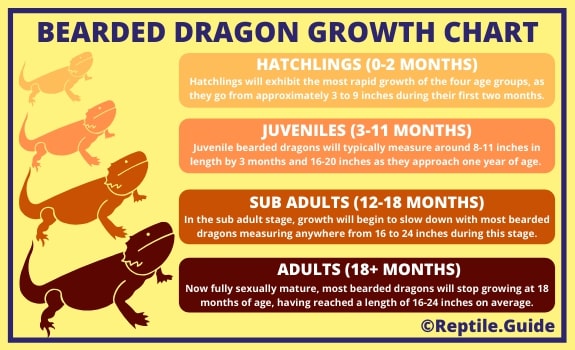
At one year old, your dragon should be anywhere from 16 to 18 inches long on average. It is at this age that your dragon will also begin to significantly slow down in their growing process.
However, by 24 months of age they can grow to be as long as 24, 25, or even 26 inches! However, more times than not, your dragon will reach it’s full length by around 18 months.
Please note the Bearded Dragon Growth Chart above to get an idea of where the average bearded dragon falls in terms of length through the first 18 months of their life.
Why Isn’t My Bearded Dragon Growing or Gaining Weight?
If your bearded dragon is below average size and weight (see the bearded dragon size chart and bearded dragon weight chart above for reference)…
Chances are there’s either something wrong with their diet, their habitat isn’t set up correctly, or you’ve let them go through brumation at too young of any age.
Read below to discover how each of these issues can lead to a small and underdeveloped bearded dragon!
Bearded Dragon Growth Problem #1: Inadequate UVB Exposure
If your dragon’s habitat doesn’t have a proper UVB bulb, then this can definitely lead to slower or stifled growth.
Bearded dragons who don’t get adequate levels of UVB are not able to appropriately absorb calcium from their diet. This can lead to a bounty of serious health problems.
Without calcium, bearded dragons can…
- Develop weak and brittle bones
- Become lethargic
- Experience stunted growth
- Develop Metabolic Bone Disease
Also, without the right UVB setup, your bearded dragon can also have a suppressed appetite, leading to stunted growth.
🤓 Expert Tip: To ensure your bearded dragon is absorbing optimal amounts of UVB, you’ll need to change their bulb(s) every 6 months. Now, if your bearded dragon has a high quality mercury vapor bulb, you can typically wait a little longer, say 6-10 months before changing it out. Just be sure to watch your pet’s energy levels, as they can become lethargic as bulbs weaken.
Bearded Dragon Growth Problem #2: Insufficient Diet
Unlike more mature bearded dragons, babies need virtually as much protein as they will eat to grow up both big and strong.
If your baby bearded dragon is under 3 months, you should be feeding them crickets 5 times a day for 5-10 minute intervals, allowing them to eat as much as they like.
And although greens and salad are a staple in a bearded dragon’s diet, they don’t really become important until around 12 months of age.
It is at this point that your bearded dragon will have most likely reached or nearly reached their full size, and as such, they will not be needing nearly as much protein. This is when vegetables should be introduced more heavily.
Bearded Dragon Growth Problem #3: Brumation
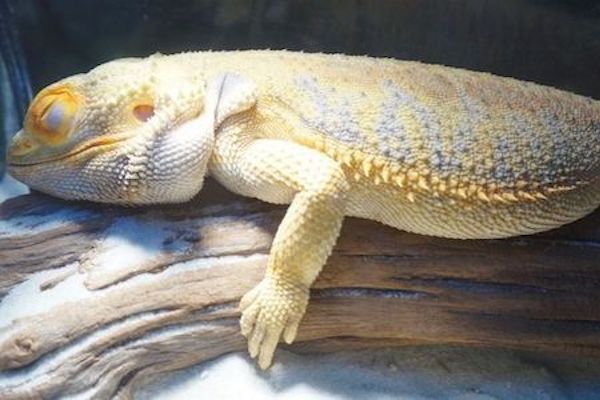
Brumation, which is essentially the reptile version of hibernation, is when a bearded dragon hunkers down and sleeps for long periods of time as they anticipate winter.
When a dragon goes through brumation, they tend to lose quite a bit of weight as they spend a good deal of time sleeping and therefore, not needing food.
Brumation can significantly stunt the growth of a younger dragon and as such, should be avoided if possible.
Avoid brumation by ensuring the temperatures in the dragon’s cage stay where they should be year-round (both during night and day) and by also making sure the lighting cycle is normal as well (10 – 12 hours of light a day, every day!).
Bearded Dragon Growth Problem #4: Disease or illness
If your bearded dragon happens to become sick whilst they’re still growing, then the can experience stunted growth.
Often times, sickly bearded dragons experience a loss of appetite. And if a growing bearded dragon is not consuming the food their body needs, then they can become weak and stop growing.
Additionally, internal parasites can also lead to slower or stunted growth as they will rob your bearded dragon of the nutrients they consume. If your bearded dragon is experiencing diarrhea or their waste is abnormally smelly – yet their diet hasn’t changed – they may have parasites.
Knowing what healthy bearded dragon poop looks like, can help you better recognize the potential presence of parasites.
The good news about this? You can almost always prevent an illness by ensuring your bearded dragon’s diet and habitat are on point.
To Keep Your Bearded Dragon Healthy And Help Them Grow…
- Deep clean their entire tank regularly
- Remove waste upon first sight
- Keep water and water bowl clean 24/7
- Ensure temperatures are where they should be
- Minimize stress
- Keep an eye on humidity levels
- Provide adequate UVB
- Offer calcium and multi vitamin supplements
- Feed a proper, well-rounded diet
If you manage to do all of the things listed above, your bearded dragon should enjoy the best possible chances of growing up big and strong!
🤓 Expert Tip: Knowing the signs of a sick bearded dragon can make all the difference in not only their recovery BUT also how much (or how little) you need to spend to get them feeling better. Brush up on the most common signs of sick bearded dragon to ensure you’re prepared in the event your pet becomes ill.
Wrapping Up How Big Do Bearded Dragons Get
All bearded dragons come into the world the same way, tiny, fragile, and weighing no more than a handful of grams. However, with the right diet and care, their growth rate skyrockets as they double, triple, and quadruple in size over a few short months!
And while there is no one size that is the standard for bearded dragons, all owners should monitor the growth of their pet to ensure they don’t become underweight or overweight.
Additionally, those that own babies or juveniles should regularly weigh and measure their pets to ensure their growth rate is not being stifled.
And should they find their bearded dragon to have stopped growing before a year’s time? Immediate action should be taken to ensure that the lighting and temperature setup is appropriate, their diet sufficient, and their pet healthy and free from parasites.
Now, make sure you know all there is about how long bearded dragons (should) live!
